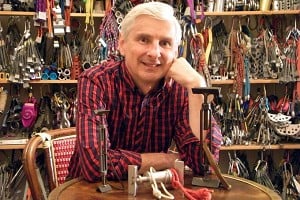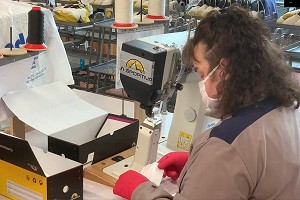
Trad is an undeniably kit-intensive activity, and when you're starting out it can be confusing as to what you do and don't need. What makes it all the more complex is that what you'll need will depend on what grade you're climbing and what rock type you're climbing on. In this article we'll try to break down the options available and the choices you'll have as you make your way up through the grades, and onto different rock types.
Before we begin, it's worth mentioning the collective term for all your climbing equipment is a 'rack'. When I started out this term confused me, as I never knew what it meant, but it basically refers to whatever equipment you own. There's no fixed definition of what a 'rack' actually is, but it will consist of some or all of the following:
The Basics
Wires
Wires are the bread and butter of a climber's rack. When you're starting out they have the benefit of being relatively affordable, whilst offering you a wide variety of potential placements, and a good quantity of them too (for the price of a single camming device you can buy at least six or more wires).
The most popular options in the UK market are DMM Wallnuts and Wild Country Rocks. These differ subtly in shape, meaning that they fit into slightly different cracks/placements, but neither is better or worse than the other - it's just a case of what you get used to.
When you're starting out you'll need at least a single full set, although as you progress it's likely you'll soon require a second set. Whether or not you buy that second set or simply choose to partner up with someone else is up to you. As and when you do get a second set it's worth considering getting a different brand from the one you've initially bought, because that will give you the widest selection of subtly different shapes and sizes.
There are many variations available, including micro, offset and half wires, but when you're starting out stick to the standard ones. We'll come to the others later on in the article, as they'll become increasingly relevant as you progress throughout the grades.
Hexes
Hexes (aka. 'cowbells') may have gone out of fashion a little lately, but they still have an important part to play, particularly as far as beginners are concerned. Not only are they an exceptionally solid piece of gear, but they are - much like wires - quite cost effective (a set of 1-4 costs around what you'd expect to pay for a single camming device).
Broadly speaking, easier routes tend to have bigger cracks/features - and this is where Hexes come in. The other benefit of them being so big is that it's much more obvious to establish a good placement, and visually verify that. In that respect it's the exact opposite of a microwire, which would require a microscope to properly inspect!
The two most popular options are DMM Torque Nuts and Wild Country Rockcentrics. The benefit of the former is that they cam into cracks better and feature a nifty doubled up sling, which acts as an extender; the benefit of the former is that as a result of their simplicity you effectively get five for the price it would cost for four Torque Nuts.
Cams
Cams are an undeniably brilliant and revolutionary piece of equipment, but one that comes at a cost. They're likely to be the single greatest investment you're likely to make as a trad climber, with a full set coming in at circa £450 and a half set at £250.
Cams are one of the more complex pieces of equipment to place as far as judgement is concerned. There's a sweet spot in terms of how cammed they are: under-camming can make them vulnerable to walking out of what would otherwise have been a positive placement; on the other hand, over-camming can mean that they'll remain in the aforementioned placement forever!
With those concerns put to one side, the benefit of cams is that they can be extremely quick to place - when placed well - and are extremely strong. They're particularly well suited to rock types such as gritstone, sandstone and granite where you tend to get a lot of parallel sided cracks.
The most popular models on the market are DMM Dragons, Wild Country Friends and Black Diamond Camalots. All three models are really good, so it's probably best just to go into a climbing shop and see which you prefer - or see which you can acquire on the most competitive deal.
Slings
Slings are another really underrated piece of equipment, perhaps because they're so simple an unglamorous. However they are one of the most versatile pieces of kit out there, as they have the ability to protect a pitch, build a belay, or reduce rope drag. It's worth carrying a few of them for that reason, preferably in a few different lengths - 60cm, 120cm and potentially even a 240cm for your belay. They're so light that there's no reason not to, and you'll never regret carrying a couple of extra.
The most commonly bought width these days is 11mm, which provides a good balance between weight and durability. If you're looking for something a little lighter then there's always 8mm, which are also better for threading, but tend not to be quite as robust (although that said, mine have lasted a long time).
Quickdraws
Quickdraws provide that vital connection between the protection that you place and the rope that connects you to your belayer below. Whilst modern developments in cams have reduced the number you might have historically needed to carry, you'll still need a fair few. After all, they're not something you want to run out of.
Wiregates tend to be the first choice from a trad climbers' perspective, mostly because of the reduction in weight. That said, there's nothing stopping you from using snapgates - they'll just be a bit heavier.
What is crucial is that you get a variety of different length quickdraws. It's all too easy to buy the shortest length available (usually 12cm) because they're invariably the cheapest; however, in order to effectively manage rope drag you're far better off getting a variety of different lengths - 12cm, 18cm, 25cm. 'Slingdraws', which are essentially a 60cm sling tripled up, are another worthwhile investment, particularly if you climb on mountain crags or sea cliffs which feature wandering routes.
Intermediate/Advanced
As you gain more experience there's a distinct chance that you'll want to look at other types of wires. There's a wide variety available and the difference between each of them ultimately lies in their shape (although there's a bit more to it than that). We'll cover the pros and cons of each below:
Alloy Offsets
Alloy Offsets are the sort of thing you'll use once, then want to use again, because they're so easy to place. Their wedge shape just seems to slot into placements easily, which is exactly what you want when you're on the sharp end. On the flip side, they're not always the easiest to get out, so take care to use a nut key in order not to damage the wires.
Alloy Offsets are available from size 7-11, although these numbers are a little confusing, and actually equate to sizes 4-8 in standard wire sizing. What I've historically done, so I'm not carrying triples of each size, is remove the equivalent sized wires from my rack and add these in their place.
Halfnuts
Halfnuts compliment a set of full sized nuts really well, insofar as they offer a good size range, but a very different shape. They're ideal for thin cracks and shallow placements. They're also 42% lighter than standard Wallnuts, although it's worth noting that as a result they're not quite as strong, and will likely require a little more TLC when removing them from cracks (no yanking upwards on those wires!).
Micro Wallnuts / Peenuts
Micro Wallnuts and Peenuts are the most affordable microwires available. The former are exactly as their name suggests - extremely small Wallnuts. The latter are best thought of as Micro Alloy Offsets, with the same wedge shape. Much like their full sized cousins, the two compliment each other in terms of their shape. In the short term Peenuts perhaps place a little more easily, but in the long run it's likely you'll want both.
Micro Wallnuts and Peenuts do have limitations though. The way in which they're constructed, with a wire loop through the head (as opposed to soldered in) means that they have to use very slender wires, which has a knock-on effect on strength, with Micro Wallnuts varying between 2-6kN and Peenuts between 4-8kN.
If you're looking for something stronger, read on…
IMP Brass Nuts / Brass Offsets
Brass nuts are the gold standard as far as microwires are concerned. With the wire soldered directly into the head a thicker, stronger wire can be used meaning that even though they're micro in size, they're impressively mighty in strength. It also means that they can go down to even smaller sizes, which is a massive benefit on routes with marginal protection.
IMPS and Brass Offsets differ in shape and, once again, it's probable that you're going to want both in the long run - especially as in the environments you tend to want to place them (i.e. in extremis) it's pretty essential you have the one that fits, whichever that might be.
Micro Cams
When I said earlier that cams were going to be the most you'd spend on a bit of kit I was primarily talking about standard sized camming devices; however, there's a whole load more money to sink into micros, as they come in at around £75 each!
Whilst you can get standard sized camming devices in smaller sizes (e.g. 0 and 00 DMM Dragonflies), a true 'micro cam' differs in several ways - they not only go down to smaller sizes, but they're narrower too, and extremely flexible. They're also remarkably strong, holding between 6-9kN, and have got me out of a whole host of sticky situations over the years.
The most popular models in the UK are the DMM Dragonfly, Wild Country Zero and Black Diamond Z4.
































Comments
Nut key -- as essential as your wires. And if you want your wires to last, make your second use them on every nut, no yankin'!
Good point.
I take exception to the title, reminds me of " building a belay", hate the term. In the distant past, was told to put in a few points and tie some knots.
Otherwise, good article, Rob. :-)
PS. Had a bad morning, spent most of it insuring a vehicle. Why should I need to spend 0.1% of my waking life sorting insurance for a car?
no mention of Totems? The most differentiated cam to the three brands mentioned… combination of narrow profile, cam shape and axles mean they fit in places the others don’t and tend to be confidence-inspiring
Everybody can have their opinion.
Ukcers generally have an obsession with totems and octavias.
I played with totems in Needlesports, have climbed with several folk with an extensive selection. Dont like em. On long pitches just used them up asap to get them off my waist.
Off topic, but whilst looking for another vehicle, tried getting into both a superb and octavia estate. Cramped but OK once inside, could hardly get in and out of the door. No thanks. Bought an expert tepee instead, always wanted a 2.0hdi pre adblue, probs blow up next week.